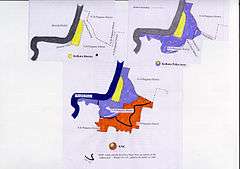Civic administration of Kolkata
The civic administration of Kolkata (the metropolitan city and the capital of the West Bengal state of India) is executed by several government agencies, and consists of overlapping structural divisions. Kolkata's administrative agencies have areas of jurisdiction that do not coincide.

Governing bodies
At least four administrative definitions of the city are available; listed in ascending order of area, those are:
- Kolkata District and the Kolkata Municipal Corporation area ("Kolkata City"),
- The Kolkata Police area,
- Greater Kolkata, which adds to the KMC area and some areas just adjacent to it,[1]
- The Kolkata Metropolitan Area.
The area within which the Kolkata Municipal Corporation (KMC) functions also has the following authorities involved in administration: the KMC itself, the Kolkata Collector (see Kolkata District), the Kolkata Police and the District Magistrate (DM) of South 24 Parganas District.
The Kolkata Collector collects land revenues in Kolkata district, the area which is administered by the KMC.[2] In 2011, Kolkata Police underwent restructuring and as of 2012, the Kolkata Police area is slightly bigger than Kolkata Municipal Area.[3]
It may seem paradoxical that a municipal area should be a subset of one urban area, since normally a district contains numerous urban areas as well as rural areas. This and the various other complications of Kolkata's government are mostly explained by the fact that Kolkata's gradual urban sprawl had somehow to be accommodated to existing political boundaries.
The KMC's entire area comprises all 144 wards of the KMC. "City" in relation to Kolkata normally refers to the KMC area (or Kolkata District only).
Kolkata Municipal Corporation
The Kolkata Municipal Corporation, or KMC, oversees and manages the civic infrastructure of the city's 15 boroughs, which together encompass 144 wards.[4] Each ward elects a councillor to the KMC. Each borough has a committee of councillors, each of whom is elected to represent a ward. By means of the borough committees, the corporation undertakes urban planning and maintains roads, government-aided schools, hospitals, and municipal markets.[5] As Kolkata's apex body, the corporation discharges its functions through the mayor-in-council, which comprises a mayor, a deputy mayor, and ten other elected members of the KMC.[6] The functions of the KMC include water supply, drainage and sewerage, sanitation, solid waste management, street lighting, and building regulation.[5]
The city also has an apolitical titular post, that of the Sheriff of Kolkata.[7] The Sheriff presides over various city-related functions and conferences.
In 2011, it was announced that Kolkata Police and Kolkata Municipal Corporation area will be almost coterminous.[8][9] In 2012, erstwhile Joka-I & Joka-II Gram Panchayats were added to municipal limits.[10] This addition increases the area of KMC to 205 square kilometres (79 sq mi).[11]
Kolkata Metropolitan Development Authority
Another ancillary civic body is the Kolkata Metropolitan Development Authority (KMDA) responsible for the statutory planning and development of the Kolkata Metropolitan Area (KMA).[12] The KMA includes a large suburban hinterland around the urban centres of Kolkata.
State government

As the capital of the state and the seat of the Government of West Bengal, Kolkata houses not only the various offices of local government listed above, but also, for the state level, the West Bengal Legislative Assembly, the Secretariat (Writers' Building) and the Calcutta High Court. Kolkata also has lower courts; the Small Causes Court for civil matters, and the Sessions Court for criminal cases.
Assembly and parliamentary constituencies
The parliamentary constituencies and assembly constituencies in West Bengal, as defined by Election Commission of India, underwent delimitation in 2008 according to the report of the Delimitation Commission.[13] Kolkata district is divided into 16 assembly constituencies (and partially 1 more also) — Kashipur-Belgachhia, Maniktala, Shyampukur, Jorasanko, Beleghata, Entally, Chowringhee, Kolkata Port, Metiaburuz (partially), Bhabanipur, Ballygunge, Rashbehari, Kasba, Behala Purba, Behala Paschim, Tollyganj and Jadavpur. There are two parliamentary constituencies — Kolkata North and Kolkata South — that have the name "Kolkata" associated with them. Chowringhee, Entally, Beliaghata, Jorasanko, Shyampukur, Maniktala and Kashipur-Belgachhia assembly constituencies form Kolkata Uttar (Lok Sabha constituency). Kolkata Port, Bhabanipur, Ballygunge, Rashbehari, Kasba, Behala Purba and Behala Paschim assembly constituencies form Kolkata Dakshin (Lok Sabha constituency).[13]
Jadavpur and Tollyganj assembly constituencies are within Jadavpur parliamentary constituency. Few wards (Ward no 136 to 141) of Kolkata Municipal Corporation (Kolkata district) area constitute part of Metiaburuz (Vidhan Sabha constituency). Metiaburuz assembly constituency also has wards from Maheshtala Municipality of South 24 Parganas District. Metiaburuz assembly constituency lies within Diamond Harbour parliamentary constituency.[13]
References
- Neighbourhoods in Kolkata
- National Atlas & Thematic Mapping Organisation, Dept. of Science & Technology, Govt. of India, Administrative Map of Calcutta, Plate 15, 2nd Edition, 1988, Reg. No. 2844 E/57 – 5002'SS.
- "Change of guard brings welcome relief". Times of India. 2 September 2011. Archived from the original on 7 July 2012. Retrieved 10 December 2011.
- "Basic statistics of Kolkata". Kolkata Municipal Corporation. Retrieved 5 February 2012.
- "KMC functions". Kolkata Municipal Corporation. Retrieved 3 December 2011.
- "Legislative structure" (PDF). Kolkata Municipal Corporation. Archived from the original (PDF) on 4 January 2012. Retrieved 3 December 2011.
- "New sheriff of Kolkata". The Telegraph. 28 December 2005. Retrieved 1 September 2007.
- "City police chief visits added areas". The Times of India. 13 June 2011. Retrieved 3 April 2013.
- Bandyopadhyay, Krishnendu (30 August 2011). "People will see the change: Kolkata police chief". The Times of India. Retrieved 3 April 2013.
- "archieve.indianexpress.com".
- "Kolkata Municipal Corporation".
- "About Kolkata Metropolitan Development Authority". Kolkata Metropolitan Development Authority. Archived from the original on 28 September 2007. Retrieved 1 September 2007.
- Delimitation Commission (15 February 2006). "Notification: order no. 18" (PDF). New Delhi: Election Commission of India. pp. 12–25. Archived from the original (PDF) on 18 September 2010. Retrieved 11 February 2012.